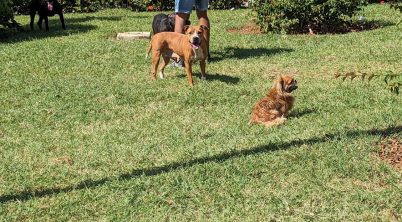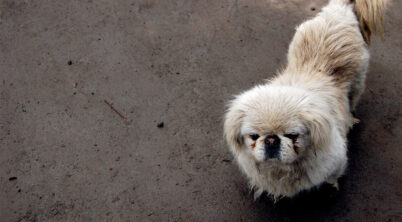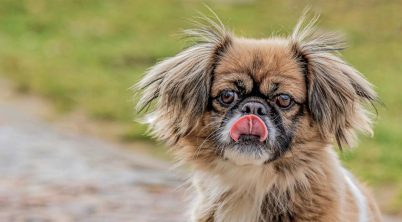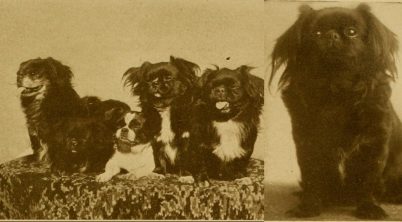Umbilical hernias are a common health issue in Pekingese dogs, caused by the incomplete closure of the umbilical ring after birth. This condition usually presents itself as a soft swelling beneath the skin, which often protrudes when the puppy is standing, barking, crying, or straining.
In Pekingese puppies, umbilical hernias are typically visible by six weeks of age as a bubble-like protrusion at the navel. These hernias can be caused by heredity, cutting the umbilical cord too short, or excessive stress on the umbilical cord during delivery. Early diagnosis and proper care are essential in ensuring the well-being of the affected animals.
Table of Contents
Understanding Umbilical Hernias
Umbilical hernias in dogs, including Pekingese, occur when there is a protrusion of the abdominal lining, fat, or organs through the umbilical ring. This leads to a noticeable bulge around the dog’s umbilicus (navel or belly button). Umbilical hernias can be of varying sizes, depending on the size of the hole in the abdominal wall.
Small hernias are generally reducible, meaning the protrusion can return to its original position within the abdominal cavity. However, non-reducible hernias are more concerning, as they could develop into strangulated hernias if not addressed. Strangulated hernias can cut off blood supply to tissues and may require urgent surgical intervention.
The Pekingese Breed and Umbilical Hernias
The Pekingese breed is known to have a genetic predisposition for umbilical hernias. An umbilical hernia occurs when there’s an opening in the muscle wall where the dog’s belly button is located. This condition can be caused by genetics, cutting the umbilical cord too short, or excessive stress on the umbilical cord during delivery.
It is important for breeders to be aware of this inherited condition and take necessary precautions during breeding processes. Some dogs may heal from their umbilical hernia on their own, while others may require surgical intervention. Monitoring and early detection of umbilical hernias in Pekingese dogs can help mitigate complications and ensure proper care.
Signs and Symptoms
An umbilical hernia in Pekingese dogs manifests as a noticeable, squishy lump around the navel or belly button area. This occurs due to the incomplete closure of the umbilical ring during birth. In some cases, the hernia may exhibit redness and swelling. The affected dog might also show behavioral changes such as depression, lethargy, and lack of appetite.
When an abdominal organ or blood vessels are involved, the hernia becomes more complicated and may lead to strangulation. This complication often causes pain, warmth at the lump’s site, and vomiting. In severe cases, infection or coughing may also be present. It is crucial to monitor these symptoms and seek veterinary attention if any sign of complication arises.
Medical Examination and Diagnosis
When a Pekingese dog is suspected of having an umbilical hernia, a veterinarian will perform a thorough physical examination. They will check for protrusion, typically located beneath the dog’s navel. This outward bulging is caused by abdominal fat or a portion of the abdominal contents pushing through the opening around the umbilicus.
The vet will assess if the dog experiences pain, warmth at the swelling site, or vomiting, as these symptoms may indicate an umbilical hernia. The presence of these symptoms, along with the physical exam, provides a basis for diagnosis.
In more complex cases, the veterinarian might opt for additional diagnostic methods, such as abdominal ultrasound, X-rays, or radiographs. These imaging techniques help to determine the extent of the hernia and the involvement of the abdominal contents, ensuring a complete and accurate diagnosis.
Treatment and Surgery
Treatment of a Pekingese dog’s umbilical hernia typically involves surgical correction. The surgical procedure includes making an incision in the affected area, pushing the protruding tissues back into the abdominal cavity, and closing the opening with sutures. This helps strengthen the muscle wall and prevents any additional abdominal content from protruding.
The recovery period for this surgery may vary depending on the severity of the hernia and overall health of the dog. During the healing process, it’s important to monitor the dog for any signs of vomiting or abnormal behavior. It’s also essential to care for the surgical incision to prevent infection or complications.
Although complications can arise, proper surgical intervention and aftercare can minimize scar tissue formation and the risk of recurrence. In cases of emergency or severe symptoms, immediate veterinary attention is necessary to ensure the best outcome for your Pekingese dog.
Postoperative Care and Recovery
After a Pekingese dog undergoes surgery for an umbilical hernia, proper postoperative care is essential for a smooth recovery. Owners must closely monitor their pet for any signs of complications, such as increased pain or swelling.
To minimize the risk of complications, strict medication adherence is advised, including pain relief and possible antibiotics. Keep the surgical site clean and dry, and prevent the dog from licking or scratching it, potentially using an Elizabethan collar.
Typically, full recovery takes several weeks, during which activity restrictions help avoid strain on the surgical site. Spaying or neutering during the hernia operation can also contribute to a more manageable recovery process.
Prevention and Healthcare
Umbilical hernias in Pekingese dogs can be a health concern. To prevent this issue, it is essential for breeders to screen their dogs for predisposed genetic factors, thus reducing the incidence of umbilical hernias. Additionally, proper nourishment and feeding during the puppy’s growth period can promote healthy development.
Owners should also provide a warm and comfortable environment for their Pekingese, as this contributes to overall well-being. Regular veterinary check-ups are crucial for early detection and intervention. Note that hernias are not related to standing, barking, or interaction with cats and Airedales.








